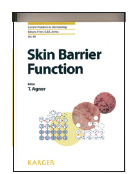Translate this page into:
Skin Barrier Function
Corresponding Author:
| How to cite this article: Khaitan B, Bhatia R. Skin Barrier Function. Natl Med J India 2017;30:300 |

Skin Barrier Function. T. Agner. Karger, Basel, New York, 2016. 164pp, price not mentioned. ISBN 978-3-318-02776-1.
Recently, there has been a renewed interest in the skin barrier and its involvement in various skin diseases. This book is being released at the right time, when there is a real need for such material. Although it has been a decade since filaggrin mutations were discovered, the exact role of the skin barrier in various diseases is yet to be elucidated. This book aims to unravel the complex interplay of the skin barrier with the immune system and all the other factors involved, including environmental and inherited.
The book contains a concise and precise description of the dynamics of the skin barrier and its practical aspects in the context of various cutaneous diseases. It is organized well, and covers the components of the basic parameters; role of the external factors that influence barrier function; tools for the assessment of the skin barrier; and the therapeutic targeting of the barrier in skin diseases. The content is comprehensive, starting from the discussion of the most well-known aspect of the skin barrier, the filaggrin mutations, to that of the other lesser known components, such as tight junction proteins and antimicrobial peptides. Considering that the subject can seem very dry, the book is presented in a manner that is easy to read.
The tools for assessing skin barrier function have been covered well. These include the well-established ones, such as the chamber method for the measurement of transepidermal water loss, as well as the new techniques, such as molecular imaging and spectroscopic methods. The physics of in vivo tests such as Raman confocal spectroscopy has been illustrated well with figures. One of the points emphasized in this book is the usefulness of topical formulations for those with conditions of skin barrier dysfunction. The differentiation between emollients and moisturizers, and finding the most suitable moisturizer for different skin conditions have always been a matter of debate. The authors have come up with evidence-based recommendations, backed by an extensive review of the literature. The table highlighting different ingredients of topical preparations for xerosis is quite useful.
Besides the well-documented role of skin barrier dysfunction in atopic dermatitis, its lesser described role in other diseases such as psoriasis has also been discussed. A good portion has been dedicated to occupational skin diseases, as well as the impact of wet work on barrier function. This is relevant because of the enormous burden of occupational skin diseases and the need for effective treatment for these. The chapter on the prevention of damage to the skin barrier covers measures to prevent occupational skin diseases at all levels (primary, secondary and tertiary).
The impact of this book could have been enhanced if it had had colour illustrations. Also, the author could have included a flow chart depicting the approach to the evaluation of barrier dysfunction to summarize these difficult-to-understand techniques and the order of priority of each of these techniques.
Overall, this is a comprehensive, easy-to-read and updated textbook on skin barrier function. With the recent upsurge in the interest in the role of the skin barrier in many (almost every ! ) skin diseases, this book will hopefully appeal to a wide audience of dermatologists. It may also be useful, especially during the early years of postgraduate training, in giving students a quick grasp of the concepts related to the skin barrier.
Fulltext Views
1,764
PDF downloads
954




